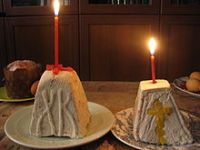Easter eggs?
Where do Easter eggs come from? Why do the children eat chocolate rabbits? And what about that game looking for hare's eggs in the garden? We take a look at the symbolism behind Easter and its traditions and we find some common values and eternal cycles of respect for reproduction and human life.

As Easter approaches, let us take a look at the symbolism behind the traditions as we celebrate and let us see how painting eggs, eating chocolate rabbits and going on an egg-hunt around the garden are proof of eternal and common supra-Continental human values which transcend time and space.
Easter eggs, chocolate bunnies, the ubiquitous children's dream at Easter time... from the end of the nineteenth century, brought to the UK and the USA by German immigrants. And indeed the Goddess of Fertility and Spring - Eostre, makes her presence on the world stage, springing from pre-Christian Pagan fertility festivities, depicted in rock engravings holding a rabbit (fertility) and an egg (eternity, no beginning and no end).
It is a time of Resurrection, the restarting of the cycle of agriculture, of life, a time of sowing, a time of planting and a time of celebration that the Winter Spirit of death (symbolic death of the agricultural cycle) has departed. The Fertility Festival is the antithesis of the first Festival of Light, which is Hallowe'en (Halo or Hallow's evening, the Night before the Saints appear) the end of the agricultural cycle and the coming of darkness.
And for those Europeans who say that Hallowe'en is a "stupid American festival" here is the rub. To be an American Festival, it either had to be born the other side of the Atlantic or else was taken there by Europeans, who since dropped the customs and had them re-introduced centuries later. It was a tremendously important festival in Medieval Europe.
The symbolic burning of scarecrows abounds in different parts of Europe either at Hallowe'en (the "Guy" in the UK), during the Festivals of Light throughout Winter (Saint Martin's Day in November, not to mention Christmas and New Year and Epiphany) or at Easter.
So these are not German festivities or American festivals, they are Universal rites based around common human values - respect for life, the celebration of resurrection, the eternal cycle of new hopes for a tomorrow bathed in light... however dark the nights may be. This eternal quest to protect and worship life has been present since humankind began communicating through rock engravings - placing a funeral stone on the breast of the deceased with zigzag lines representing waves (the water of life) or the feathers of the night-Goddess, the Owl (brought by the Moon).
Waves are water, water is life.
In Russia, people boil eggs and colour them, drawing designs or patterns on top of the coloured paint. Red-coloured eggs represent the Blood of Christ.
Good Friday is called Strastnaya Pyatnitsa and Easter Sunday is Pashalnoye Voskresenye, after the Easter Service at Church on Saturday. At midnight the priest says Khristos Vosgres! (Christ is risen!) and the congregation says Voistinu Vosgres! (Truly He is risen!) Whether or not they went to Church service, on Easter Sunday people say this and perform the Kiss of Peace or Khristosovanie (Kissing three times).
Easter Sunday is celebrated with the Easter Breakfast, which ends the Great Lenten Fast, and which consists of many dishes. Typical dishes are Kulich (Easter Bread, symbolizing the Body of Christ, with a cross on top) and Paskha, Easter Cake (a pyramid-shaped dish made from cheese curds).
Charitable offerings are made to the poor, needy and orphanages.
Photo: Paskhas in the foreground, Kulich and eggs in the background
Timothy Bancroft-Hinchey
Pravda.Ru
Subscribe to Pravda.Ru Telegram channel, Facebook, RSS!


